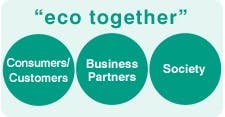For their lighter footprint and higher standards, green products often demand higher prices, but is this how it should be?
Speaking at a recent sustainable business summit in Singapore, chief executive of the United Nations Environment Programme Achim Steiner posed this question: “Is the customer making the sustainable choices the one who should be paying the premium?”
Sustainability experts across the globe are realising that consumer behaviour holds the key to reducing the environmental impacts of the world’s rapidly growing urban populations, alongside high-tech solutions such as green buildings, clean energy and more efficient transport.
This is because even the best technology will not be enough if cities - and their people - cannot change their high-consumption lifestyles. Simply put, sustainable cities require sustainable consumers.
“Whether we like it or not, today we are automatically part of a high consumption system,” said Professor Steffen Lehmann, director of the Centre for Sustainable Design & Behaviour (sd+b) at the University of South Australia, in a recent interview. “One cannot have infinite growth and consumption on a planet with finite resources.”
Many are over-consuming in societies where progress is measured by how quickly people can extract, produce, consume and waste things, and it is time for a wake-up call, he noted.
The manufacturing, consumption and disposal process is a symptom of the current ‘pipeline’ mentality, which society must abandon if it is to stop wasting resources, he added. In its place, society needs to develop a ‘no-waste’ ethos through which products and services are designed and managed to systematically avoid and eliminate the waste of materials.
“Today, it is technologically possible to build a zero-waste and zero-carbon-emission city. The question is: Are we willing to do so and transform from consumers to citizens?” he asked.
Conventional measures like recycling programmes will not be enough; such a transformation will require companies to change the way they create and recover products, noted Professor Lehmann. It will also require new business models such as car-sharing schemes, he added.
As UNEP’s Mr Steiner has noted, eco-friendly products – typically manufactured in relatively small quantities for niche markets - have conventionally cost consumers more money. However, a growing number of multinational manufacturers are beginning to measure the environmental and social impacts of their business beyond the boundaries of their factories, and they are making strides at greening the products that consumers already buy.
Professor Lehmann called this extended producer responsibility, and noted that it is becoming more common despite the fact that many companies – driven by their marketing departments - are still pretending to have greener products than they really have.
“Extended producer responsibility means that companies…cannot walk away from the legacy of their produced stuff and its environmental damages,” he said.
At the moment, he has doubts that the manufacturing industry overall is making much progress towards sustainable consumption because over-hauling existing supply chains is difficult and costly.
“The real change will only happen when consumers demand it. This is why we need to have more well-informed consumers,” he said.
“At the end of the day, if the product cannot be 100 per cent recycled, re-used or composted then the company should not be producing it and we should not be buying it,” he said.
In this special report, Eco-Business showcases some leading manufacturers on the measures they have taken to reduce the impact of urban consumption on natural resources.
Puma: Quantifying natural capital

Clothing manufacturer Puma last year became the first multinational to include environmental costs in an environmental profit and loss statement. Puma chief executive Jochen Zeitz said that he had been surprised by the results of the life cycle analysis of the firm’s products, which showed that the production and processing of raw materials such as cotton, rubber and leather accounted for 76 per cent of the overall environmental cost of 145 million Euros (nearly US$190 million).
In terms of carbon footprint, the emissions generated by the company’s factories were minimal compared to the supply chain.
“So, even if we go carbon neutral in our factories, we only impact 6 per cent of our footprint,” he said at a recent sustainable business forum. He added that putting the impacts in monetary terms resulted in better decisions during the product design and development stages.
Puma is now working on applying the environmental costs to individual products, so the customer can compare when shopping. Mr Zeitz said he hoped industry could find easy, standardised ways to communicate these costs – something along the lines of “environmental calories” - so that the consumer can make informed choices.
“As a large international brand, we know that we have an opportunity to help change consumer behaviour when it comes to sustainability and also inspire others to do the same,” he told Eco-Business in an e-mail interview.
Kao: Working with customers towards eco-friendly habits

The Japanese firm Kao, whose 34,000 employees produce cosmetics, household goods and chemicals for the global market, has a research and development team of thousands looking for ways to reduce the environmental impacts of its products in the homes of customers. The company set up an Eco-lab museum in Japan for business partners, school groups and the public to raise awareness and help change habits. Museum director and research fellow Mazaki Tsumadori told Eco-Business in Singapore recently that about half of the firm’s overall emissions occur after the customer takes home its products, and that the firm focussed on developing products that use less water and less energy to heat water, and generate less waste.
After conducting thorough research on consumer habits and lifestyles in different markets, the firm introduced product innovations such as concentrated laundry detergents to reduce packaging and the energy needed for transport. Over the years, they have also developed refill packs for soaps and detergents and reduced the amount of water needed for rinsing.
Mr Tsumadori noted that consumers could only play their part in a more sustainable lifestyle if companies provided the necessary information. He also cautioned against having trade-offs: “If the products cost more or do not perform as well, they will not work for the mainstream.”
Philips: Creating new business models

Dutch electronics firm Philips was recognised earlier this month as a “Green Game-changer” by WWF-UK for a new business model that overcomes the problem of high up-front costs for energy efficient LED lighting. Its Pay Per Lux leasing scheme allows businesses to install the energy-saving lights without the expense of the fixture or the hassle of recycling the parts at the end of their use. Philips is preparing to scale up the model after the success of its first test case in the Netherlands.
Robert Metzke, senior director Philips’ EcoVision Program, said in a WWF report that eco-friendly technology often provided benefits that were not directly beneficial to the customer. “It’s challenging to find new ways to include these additional benefits into your business model,” he added.
Philips’ current sustainability blueprint, called Eco-Vision5, calls for a 50 per cent improvement in its products’ energy efficiency from 2009 levels by 2015 and progress towards closing the material loop through natural resource efficiency and recycling.
Mars: Maximising impacts

The privately held Mars Corporation, the US-based maker of M&M chocolate candies and other food products, concentrates its sustainability efforts where its massive size and big brand recognition give it an edge – with the small-holders in its supply chain on one end, and the individual customers on the other. Chief sustainability officer Andrew Hobday said in an interview that while big companies could have tremendous negative impacts on the environment, they also had the opportunity to affect the lives of many people in a responsible way.
The firm, which uses 12 to 15 per cent of the global cocoa supply, is currently the largest purchaser of certified sustainable cocoa and has committed to using only certified cocoa by 2020. Mars is investing heavily in scientific research on cocoa farming and in programmes to help small-holder farmers improve their yields and reduce environmental impacts.
In Africa, where most of the cocoa is grown, better techniques such as intercropping can improve yields up to five times the current average, and Mars has an incentive to help farmers achieve so this so that they do not move out of farming, he said.
As little as 25 years ago, companies never worried about the supply chain, and were only concerned with getting good quality at a good price, noted Mr Hobday. However, now companies are taking a long term view and working to strengthen the science.
Mars also applies its long-term view to customers. In recognition of the public health issues associated with many snack foods, the firm is careful to market its snacks as occasional treats, and never to children under 12. It has also reduced portion sizes and introduced resealable packaging to encourage people to eat less in a sitting. “We want people to continue to enjoy and buy the products, and we recognize that we can do our part to ensure that,” he said.
The company is also working on different ways of providing positive environmental and social responsibility messages on its products.
Panasonic: User-friendly, environment-friendly systems

Japanese electronics firm Panasonic has been creating interactive systems to help consumers improve energy efficiency without sacrificing comfort or lifestyle. In August, the company launched a new integrated energy management application through which customers could connect to their home appliances over the internet. The app lets people check energy efficiency settings and control appliances, and also provides useful tips.
The general manager of Panasonic’s solutions development group, Yasuyuki Shintani, said that the ultimate goal was to minimise household energy use with a range of Panasonic products such as insulation, air-conditioners, appliances and grid-connected demand-response energy management systems. The key, he added, was to design for efficiency for the entire household from the beginning.
He called energy efficiency the ultimate strategy to achieve sustainable cities. This is especially true for emerging countries, where conventional thinking is usually to build new power plants rather than find ways to save energy, he added.
Fuji Xerox: Staying the course

Fuji Xerox product developer Motofumi Baba spent 14 years working on a multi-function copier that would not keep customers waiting while the machine warmed up. He said he was motivated by the fact that people were not using the energy efficiency settings on the Japanese manufacturer’s machines because they were too impatient to wait for copiers to wake from sleep mode. The zero-wait copier was launched earlier this year as part of the company’s Real Green solutions range.
Fuji Xerox applied the same persistence to its zero-waste goals. When the company had trouble sourcing qualified recycling operations for its product take-back scheme in Asia, it built its own facility in Thailand and trained local workers to safely perform the task. Another facility located in China enables the firm to recycle all of the products it collects from within Asia at the end of their lifespans. Fuji Xerox remanufactures as much material as possible for use in new machines.













